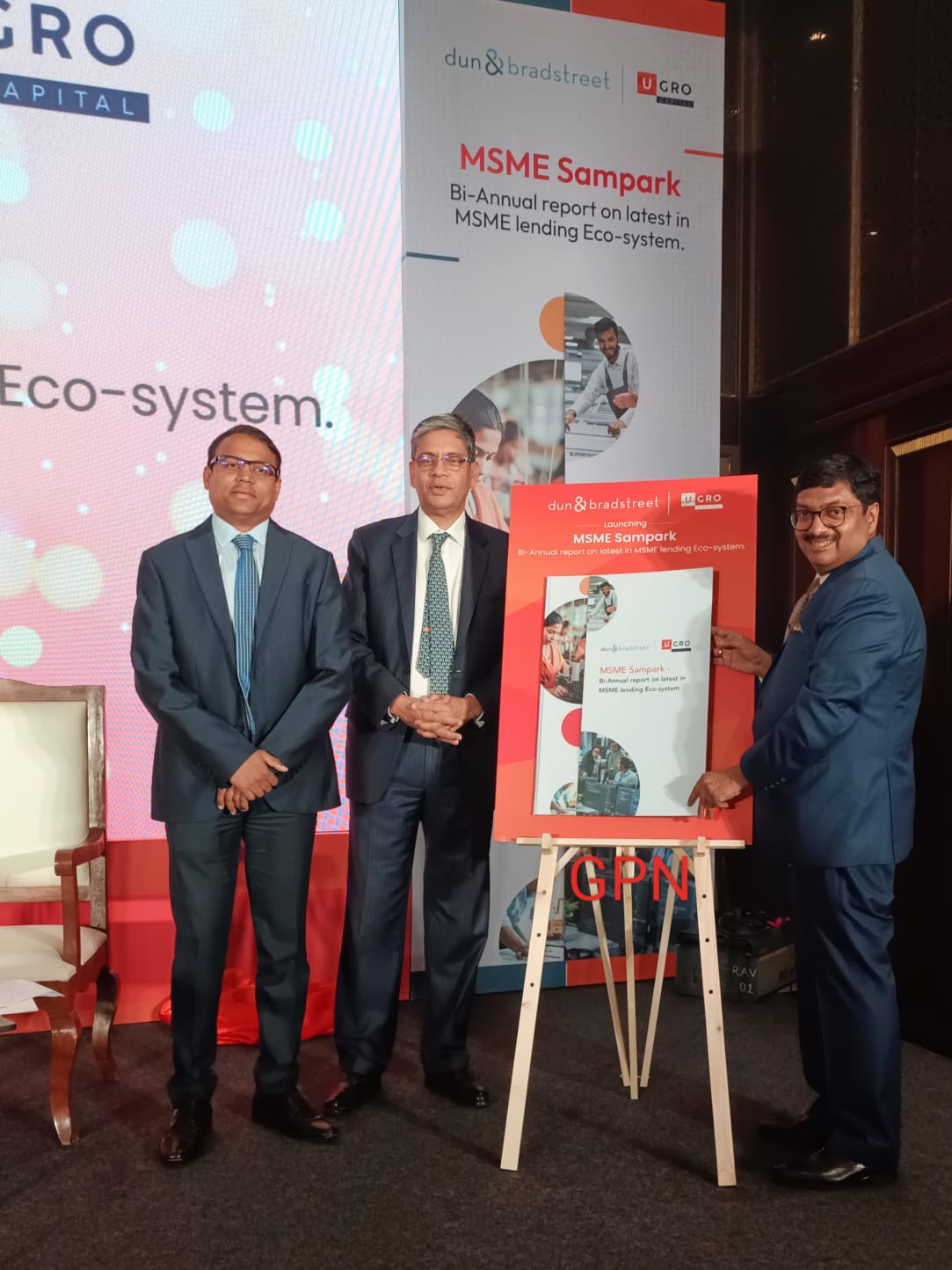
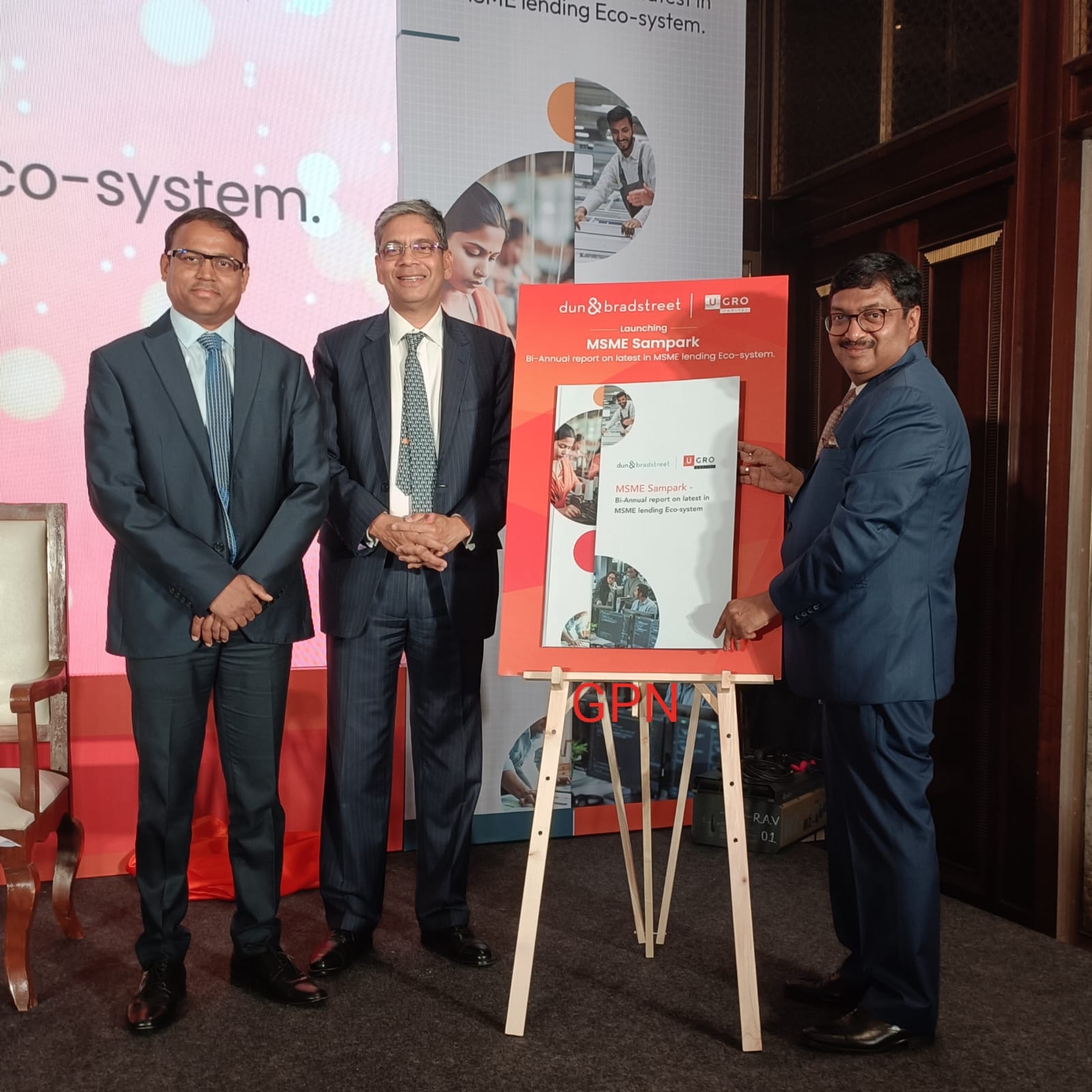
L-R: Dr. Arun Singh, Global Chief Economist, Dun & Bradstreet with Mr. Avinash Gupta, MD & CEO – India, Dun & Bradstreet and Mr. Shachindra Nath, Founder and Managing Director, U GRO Capital during launch of MSME Sampark bi-annual report on the latest in MSME lending ecosystem’ by U GRO Capital and Dun & Bradstreet – Photo By GPN
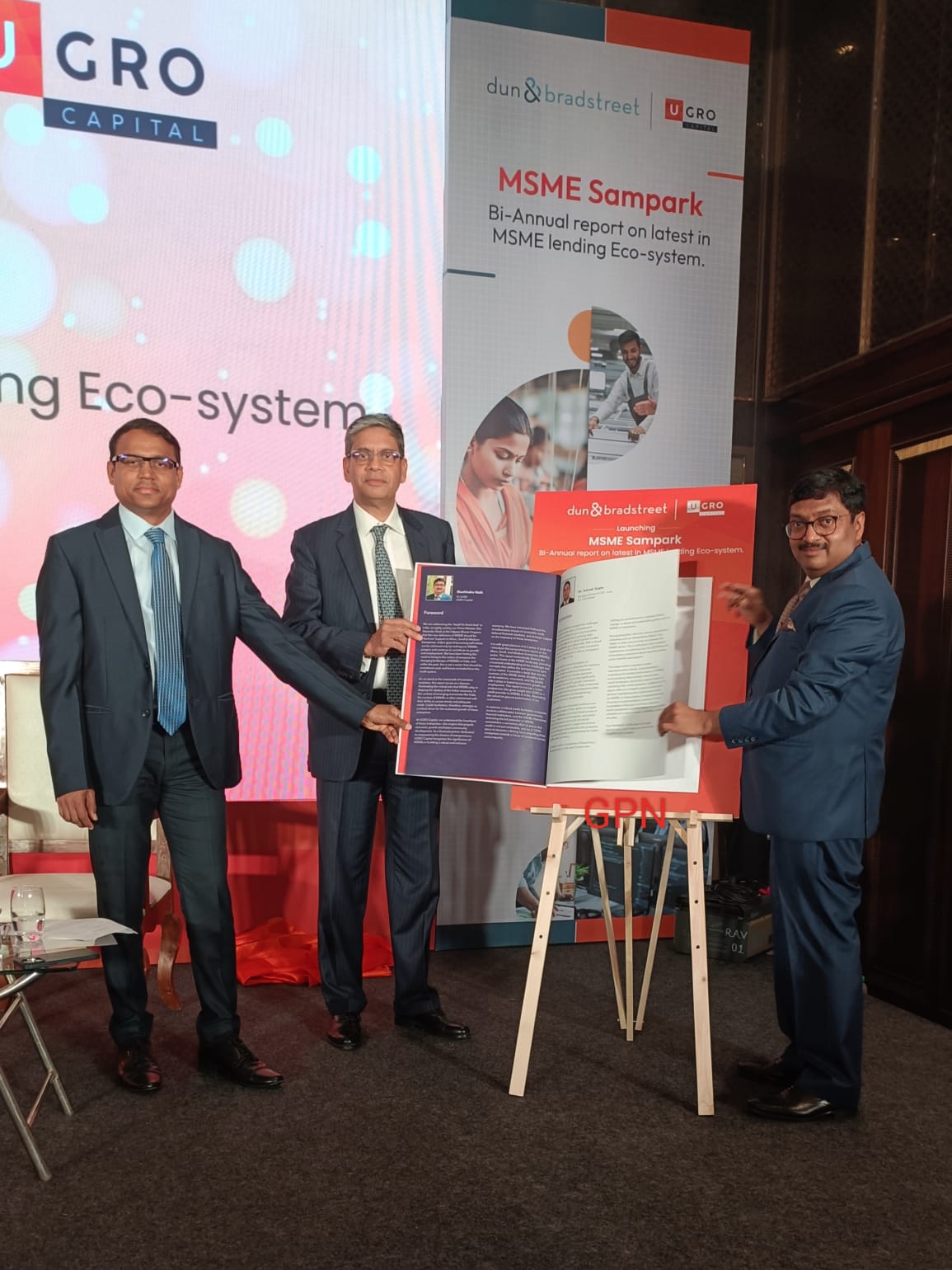
L-R: Dr. Arun Singh, Global Chief Economist, Dun & Bradstreet with Mr. Avinash Gupta, MD & CEO – India, Dun & Bradstreet and Mr. Shachindra Nath, Founder and Managing Director, U GRO Capital during launch of MSME Sampark bi-annual report on the latest in MSME lending ecosystem’ by U GRO Capital and Dun & Bradstreet – Photo By GPN

L-R: Dr. Arun Singh, Global Chief Economist, Dun & Bradstreet with Mr. Avinash Gupta, MD & CEO – India, Dun & Bradstreet and Mr. Shachindra Nath, Founder and Managing Director, U GRO Capital during launch of MSME Sampark bi-annual report on the latest in MSME lending ecosystem’ by U GRO Capital and Dun & Bradstreet – Photo By GPN
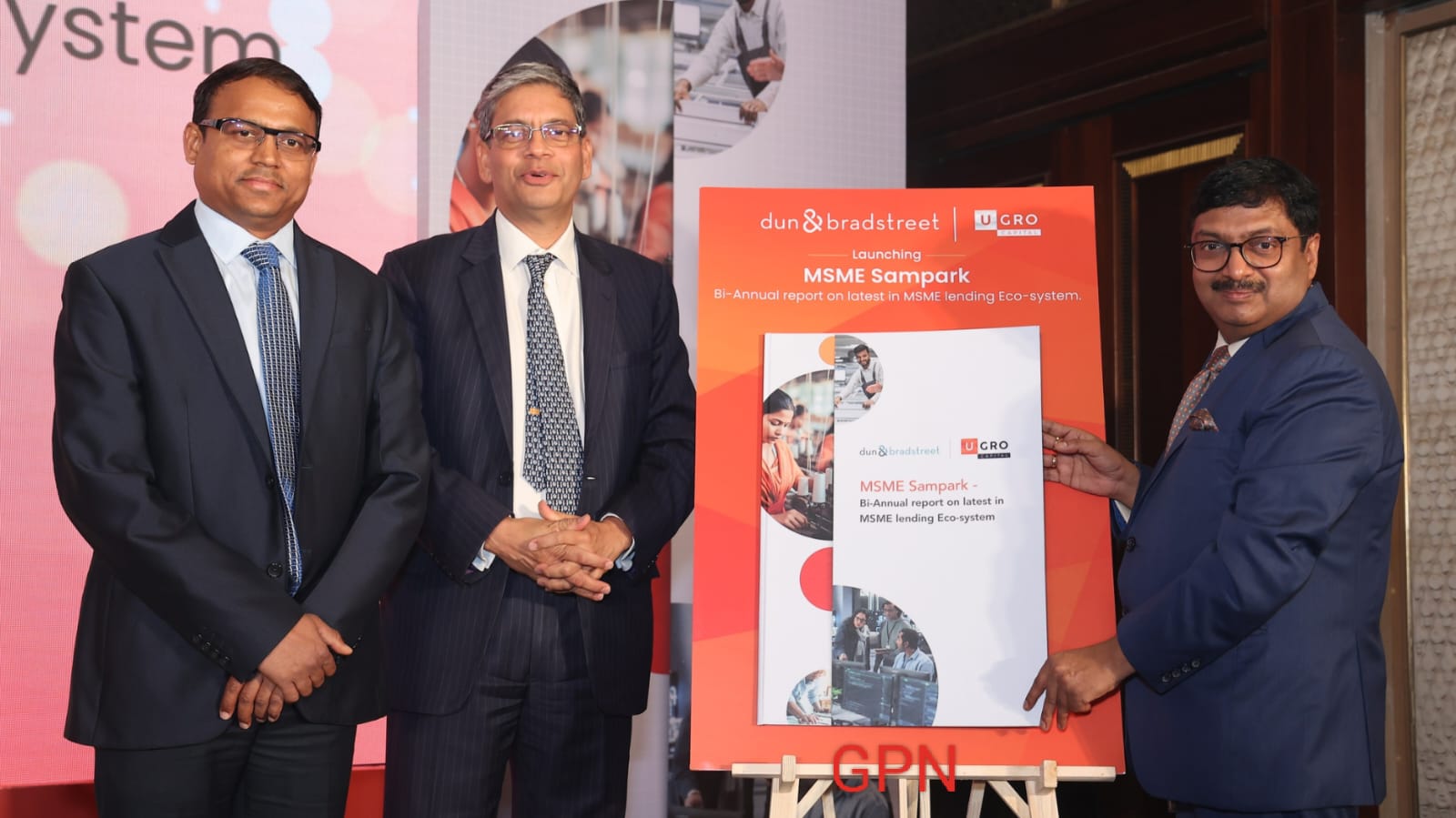 Share Of Credit To MSMEs Set To Grow: MSME Sampark – Half Yearly Report -By U GRO Capital and Dun & Bradstreet
Share Of Credit To MSMEs Set To Grow: MSME Sampark – Half Yearly Report -By U GRO Capital and Dun & Bradstreet
MUMBAI, 5th FEBRUARY, 2024 (GPN): A joint report by U GRO Capital and Dun & Bradstreet, titled — MSME Sampark — A Bi-annual report on the latest in MSME lending ecosystem’, takes a close look at where the Indian MSME segment is positioned now after having stepped out of the COVID-19 pandemic, the credit scenario in the segment, the formalisation of credit in the segment and the increasing ticket size of loans, among others. The report also signals optimism for domestic demand and profitability and is highly optimistic of the increasing capex and hiring by MSMEs which bodes well for the overall growth momentum.
The report on lending to the MSME sector has said the share of formal credit to the MSME segment is set to rise because of several factors, including the Reserve Bank of India’s decision to curb unsecured loan growth.
Both Scheduled Commercial Banks (SCBs) and non-banking finance companies (NBFCs) have increased their share of credit to micro and small firms in FY23 compared to the pre-pandemic period.
According to the report over 50% of MSMEs with turnovers less than Rs 10 crore witnessed Year-on-Year (YoY) growth of over 10%. This growth is a positive sign of recovery and resilience in smaller entities within the MSME sector, the report said.
India’s Micro, Small and Medium Enterprises (MSME) ecosystem plays a vital role in shaping and growing the country’s economy. Post the COVID-19 pandemic, that is, from FY21 to FY22, the contribution of MSMEs to India’s Gross Value Added (GVA) has grown significantly.
Mr. Shachindra Nath, Founder and Managing Director, U GRO Capital, said: “This report highlights the critical role that MSMEs play in shaping the destiny of the Indian economy. It takes a deep dive into the nuances of the MSME sector, shedding light on its resilience, innovation, and the pivotal role it plays in fostering economic growth and employment.”
Mr. Avinash Gupta, MD & CEO – India, Dun & Bradstreet, said “India aims to be a US$30 trillion economy by 2047, roughly 8x increase in two decades. MSMEs contribute nearly a third of India’s GDP. It is imperative that MSMEs scale up significantly and quickly, necessitating estimated US$11.5 trillion financing requirement in fixed assets. The MSME Sampark report jointly produced by Dun and Bradstreet and UGRO Capital aims to track MSMEs performance, credit behaviour and financial environment on a bi-annual basis. We have observed that businesses optimism of MSMEs has soared to the highest level since 2022, indicating improvement in performance even in the face of difficult external environment. Moderate delinquency rates and low sector risks have also improved MSMEs borrowing prospects. The Government’s continued thrust on formalization is furthering the formal credit penetration in the sector”.
The MSME Segment: Where It Stands Now:
Post-pandemic, India is one of the fastest growing major economies. India’s real gross domestic product (GDP) at constant prices (2011-12) grew by a faster-than-expected 7.6% in the July September quarter of 2023. For the full financial year, the economy is expected to register 7.3% growth, compared to 7.2% a year ago.
In this background, the report says that post-pandemic, good recovery was seen in smaller entities, though at a slower pace than the larger ones: over 50% of entities with turnovers less than Rs 10 crore witnessed Year-on-Year (YoY) growth of over 10%, compared to ~60% for higher turnover entities. Over a three-year period, 25,000+ MSMEs were studied to prepare this report. The study showed a dip in business and sales activity in the year of the pandemic, followed by a massive 77% of customers showing resumption of activity in the first year after the pandemic, and over 68% of customers showing over 10% Y-o-Y sales growth in the second year after the pandemic. As a result, risk levels have fallen and delinquency rates have improved in the MSME segment which, in turn, is improving the prospects of borrowings by MSMEs. This is resulting in increased credit growth and the share of credit disbursed to MSMEs by Scheduled Commercial Banks (SCBs) and non-banking finance companies (NBFCs).
MSME’s Credit Standing
According to the report, MSMEs are increasingly realising that to grow, getting formal recognition is vital, which will help them receive credit from formal institutions (banks and NBFCs) and the various benefits offered by ongoing and future schemes from the government. This is seen from the fact that since the inception of UDYAM in 2020, MSME registrations on the platform have increased 2.4 times, while they have generated 1.6 times more employment opportunities by FY23. A study done across 10,000+ micro-sized MSMEs shows rising credit penetration in the sector reflecting the lenders’ positive view on their resilience and recovery.
Formalisation of Credit
Formal credit penetration to MSMEs is expected to increase as the government acts proactively towards the formalization of MSMEs. India’s credit penetration of 52% is the lowest among its Asian peers: China stands at 185%, South Korea at 175%, and Vietnam at 126%. The Bank credit to Gross State Domestic Product (GSDP) ratio for the majority of states is below the national average; only Maharashtra, Telangana, Tamil Nadu and Delhi have credit to GSDP ratio penetration above the national average. Now, as the MSMEs get formalised through the various direct and indirect incentives that the government (Central and State) undertakes, formal credit penetration to MSMEs is expected to increase. Also, thanks to the various policy interventions taken by the government to increase the productivity and competitiveness of MSMEs, skill development, technology upgradation and market access, MSMEs are likely to grow which is crucial in sustaining the current momentum.
Increasing Ticket Size of Credit
Ticket size of loans by lenders to MSMEs has increased post-COVID-19, while approval rates have fallen indicating cautiousness after the removal of pandemic relief measures.
Healthy penetration of credit is seen across sectors and geographical footprints across the studied universe of business entities. Interestingly, smaller entities are seen borrowing more relative to their scale of business to meet capital needs during a growing phase. Maharashtra, Gujarat, and New Delhi top the list in the distribution of debt, while Light Engineering, Hospitality, and Healthcare are the sectors that attracted the most debt.
Since the UDYAM platform’s inception in 2020, MSMEs have seen a 2.4 times increase in registrations by FY23. They have also generated 1.6 times more employment opportunities, emphasizing their contribution to job creation. The UDYAM portal, launched by the Ministry of Micro, Small, and Medium Enterprises (MSME) in India, serves as an online platform for the registration and classification of micro, small, and medium enterprises. The objective is to formalize and promote the MSME ecosystem in India.
Despite the ongoing global economic slowdown, the optimism level among small businesses peaked in Q4 2023, the highest since 2022. This positive sentiment indicates a favourable outlook for MSMEs. The report highlights that risk to MSMEs moderated in 2022 compared to 2019. Lower risk levels and declining delinquency rates contribute to the improved borrowing prospects for MSMEs.
The study shows rising credit penetration in the MSME sector, reflecting lenders’ confidence in their resilience and recovery. Both Scheduled Commercial Banks (SCBs) and non-banking finance companies (NBFCs) have increased their share of credit to micro and small firms in FY23 compared to the pre-pandemic period.
Post-pandemic, there has been an increase in the ticket size of loans by lenders to MSMEs. Although approval rates have fallen, the larger loan sizes suggest that lenders are cautiously optimistic about providing substantial credit to MSMEs.Ends

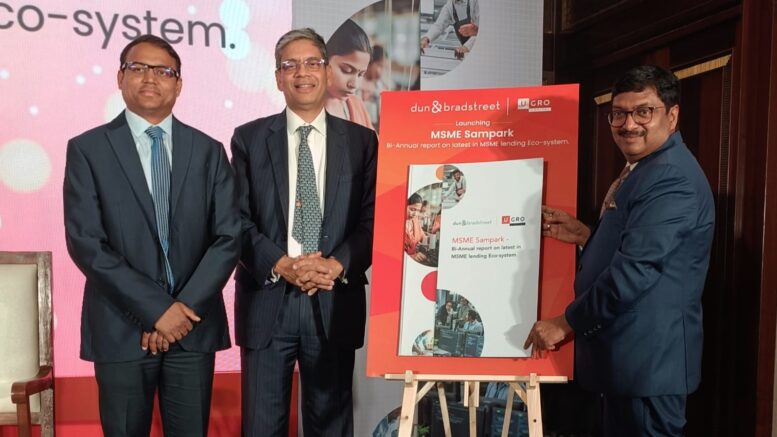
Be the first to comment on "Dun & Bradstreet and U GRO Capital Launches MSME Sampark – A Bi-Annual report on latest in MSME lending Eco-system"